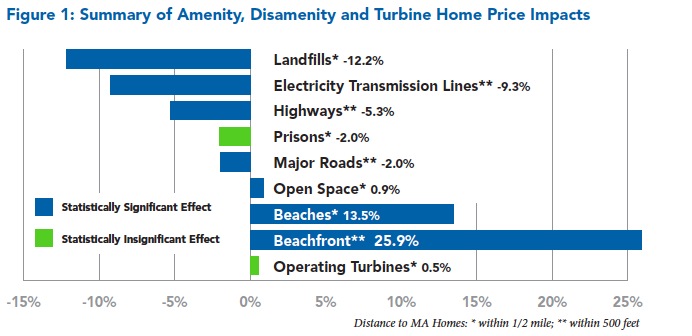UNIVERSITY OF CONNECTICUT
LAWRENCE BERKELEY NATIONAL LABORATORY
Executive Summary
This study investigates a common concern of people who live near planned or operating wind developments: How might a home’s value be affected by the turbines? Previous studies on this topic, which have largely coalesced around non-significant findings, focused on rural settings. Wind facilities in urban locations could produce markedly different results. Nuisances from turbine noise and shadow flicker might be especially relevant in urban settings, where negative features, such as landfills or high voltage utility lines, have been shown to reduce home prices. To determine if wind turbines have a negative impact on property values in urban settings, this report analyzed more than 122,000 home sales, between 1998 and 2012, that occurred near the current or future location of 41 turbines in densely-populated Massachusetts communities.
The results of this study do not support the claim that wind turbines affect nearby home prices. Although the study found the effects from a variety of negative features (such as electricity transmission lines and major roads) and positive features (such as open space and beaches) generally accorded with previous studies, the study found no net effects due to the arrival of turbines in the sample’s communities. Weak evidence suggests that the announcement of the wind facilities had a modest adverse impact on home prices, but those effects were no longer apparent after turbine construction and eventual operation commenced. The analysis also showed no unique impact on the rate of home sales near wind turbines. These conclusions were the result of a variety of model and sample specifications detailed later in this report.
Wind power generation has grown rapidly in recent decades. In the United States, wind development centered initially on areas with relatively sparse populations in the Plains and West. Increasingly, however, wind development is occurring in more populous, urbanized areas, prompting additional concerns about the effects of wind turbine construction on residents in those areas.
One important concern is the potential for wind turbines to create a “nuisance stigma”—due to turbine-related noise, shadow flicker, or both—that reduces the desirability and thus value of nearby homes. Government officials who are called on to address this issue need additional reliable research to inform regulatory decisions, especially for understudied populous urban areas. Our study helps meet this need by examining the relationship between home prices and wind facilities in densely-populated Massachusetts.
A variety of methods can be used to explore the effects of wind turbines on home prices. Statistical analysis of home sales, using a hedonic model, is the most reliable methodology because it (a) uses actual housing market sales data rather than perceptions of potential impacts; (b) accounts for many of the other, potentially confounding, characteristics of the home, site, neighborhood and market; and (c) is flexible enough to allow a variety of potentially competing aspects of wind development and proximity to be tested simultaneously. Previous studies using this hedonic modeling method largely have agreed that post-construction home-price effects (i.e., changes in home prices after the construction of nearby wind turbines) are either relatively small or sporadic. A few studies that have used hedonic modeling, however, have suggested significant reductions in home prices after a nearby wind facility is announced but before it is built (i.e., post-announcement, pre-construction) owing to an “anticipation effect.” Previous research in this area has focused on relatively rural residential areas and larger wind facilities with significantly greater numbers of turbines.
This previous research has done much to illuminate the effects of wind turbines on home prices, but a number of important knowledge gaps remain. Our study helps fill these gaps by exploring a large dataset of home sales occurring near wind turbine locations in Massachusetts. We analyze 122,198 arm’s-length single-family home sales, occurring between 1998 and 2012, within 5 miles of 41 wind turbines in Massachusetts. The home sales analyzed in this study occurred in one of four periods based on the development schedule of the nearby turbines (see Figure 2). To estimate the effect proximity to turbines has on home sale prices, we employ a hedonic pricing model in combination with a suite of robustness tests3 that explore a variety of different model specifications and sample sets, organized around the following five research questions:
- Q1) Have wind facilities in Massachusetts been located in areas where average home prices were lower than prices in surrounding areas (i.e., a “pre-existing price differential”)?
- Q2) Are post-construction (i.e., after wind-facility construction) home price impacts evident in Massachusetts and how do Massachusetts results contrast with previous results estimated for more rural settings?
- Q3) Is there evidence of a post-announcement/pre-construction effect (i.e., an “anticipation effect”)?
- Q4) How do impacts near turbines compare to the impacts of amenities and disamenities also located in the study area, and how do they compare with previous findings?
- Q5) Is there evidence that houses near turbines that sold during the post-announcement and post-construction periods did so at lower rates (i.e., frequencies) than during the pre-announcement period?
About the University of Connecticut
www.uconn.edu
“The University of Connecticut is a Carnegie Foundation Research University, lauded for breadth and range of research. More than 100 research centers and institutes serve UConn’s teaching, research, diversity, and outreach missions. Undergraduate, graduate, and faculty research at UConn drives business development and enhances quality of life.”
About the Lawrence Berkeley National Laboratory
www.lbl.gov
“Berkeley Lab is a member of the national laboratory system supported by the U.S. Department of Energy through its Office of Science. It is managed by the University of California (UC) and is charged with conducting unclassified research across a wide range of scientific disciplines.”
Tags: Lawrence Berkeley National Laboratory, MA, Massachusetts, Massachusetts Clean Energy Center, Property Values, Real Estate, University of Connecticut, Wind Energy







 RSS Feed
RSS Feed